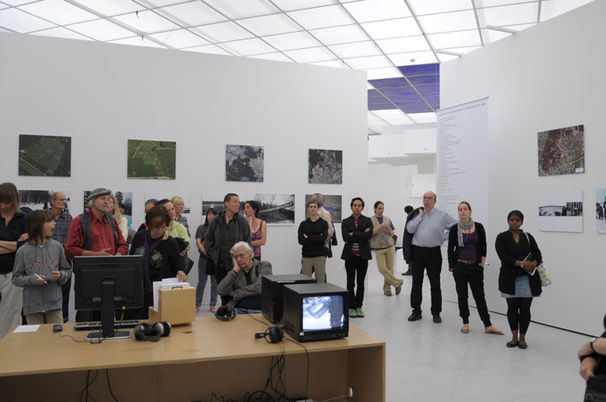Collective actions
SUBVERSIVE PRACTICES:
Art under Conditions of Political Repression
60s–80s / South America / Europe
May 30 – August 2, 2009
Idea and Concept
Iris Dressler, Hans D. Christ
Württembergischer Kunstverein Stuttgart
https://www.wkv-stuttgart.de/en/program/2009/exhibitions/subversive/
Collective Actions: Trips out of Town, 1976–2009
Curator: Sabine Hänsgen
Installation as diagramm
24 digital prints of photo documentations (numbered)
16 digital prints of satellite images (numbered)
4 banners with all titles of the Trips out of Town (German / Russian)
24 texts with descriptions of actions in card box (German / Russian, numbered)
2 videos, 1 web presentation (https://conceptualism.letov.ru)
The performances by the group Collective Actions played a significant role in the
development of an alternative space for communication in Russian-Soviet culture during late communism. They facilitated the self-organization of a subcultural art scene apart from the state-controlled cultural sector, access to which was regulated by strict
censorship policies.
In relation to the rhetorics of power characterizing official political rituals—as carried
out in the symbolically charged architectural space of the metropolis of Moscow—it was an ironic effect that was manifested by the Collective Actions. The common objective of the “Trips out of Town,” having taken place since 1976, is the collaborative journey of a group of participants into the rural countryside around Moscow—usually into a wide, empty field, that is, away from the metropolitan sphere imbued with symbols and into an “empty” natural space. Often a field of untouched snow has been the stage for Minimalist actions that fathom elementary spatiotemporal structures of perception and provoke a range of different interpretations through their enigmatic nature. The white field—referencing the suprematist tradition of Kazimir Malevich, the white paintings by Ilya Kabakov, or Martin Heidegger’s “clearing”—becomes a demonstration space for the artists and a place of perception and reflection for the participants.
For the Collective Actions, the exploration of the Soviet ideological culture of texts,
manifestos, and slogans has not been reduced to the instantaneous perception of a
situation. In fact, the situative gesture of “experience” more closely equates to a new
impulse in an endlessly interpretative spiral in which situation and documentation
enhance each other again and again.
In the exhibition, the “installation as diagram” enables visitors to more thoroughly study the multifaceted documentary materials (descriptive texts, narratives, theoretical
commentary, discussions, drawings, photographs, videos) as an intricate web of
interrelationships, thus making them participants in the process of reconstructing the
action events.
By opening a “planetary” perspective through recent satellite images—upon which the
respective localities where the Collective Actions have taken place over the course of
thirty years are marked—the artistic reflection of ideology and power in late
communism is extended to comprehend contemporary processes of globalization.
(Sabine Hänsgen)





